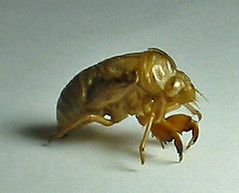Heat bugs: all the buzz
"Heat bugs" may never show up on Google's list of top keyword searches, but in the last week we've had more hits on a post about cicadas we put up last summer (Heat bugs: the sound of money) than any topic to date.
It's typically on hot summer days that male cicadas produce their raspy, buzzing mating calls, earning this group of insect families their nickname, heat bugs. Given the steamy weather that came with the Bermuda High that stalled over Connecticut this past week it's easy to imagine why so many people were searching the net for information about them.

Above: The recently shed exoskeleton, or carapace, of a cicada or heat bug.
Cicadas come in two varieties, the so-called annual cicadas, generations of which generally emerge from the ground as nymphs, shed their skin, mature to adults and mate every couple of years, and the periodical, (also known as locusts) which have generations that emerge all at once, together, in cycles of between 13 and 17 years. Cicadas are harmless, unless you're a plant, in which case they may well try to suck the juice out of you.
A great site with lots of (useful?) information about cicadas (e.g. don't eat 'em because they're loaded with mercury!) is Cicada Mania by Dan Century.

One of the best sites for information about periodical cicadas is The University of Michigan Museum of Zoology, Insect Division site. Two UConn researchers, John Cooley (above left) and David Marshall (above right) and Mark O'Brien are the authors of the site. Cooley and Marshall were featured in Cicada Subtleties, an article about periodical cicadas posted on Science News Online.
So, the next time you're sweating out another heat wave and trying to figure out what makes heat bugs call on hot days, try visiting a couple of these sites. And if you find yourself really getting into it, check out UConn Professor Chris Simon's site for the skinny on cicadas and their broods' cycles around the world.
0 Comments:
Post a Comment
<< Home